- The paper presents detailed JWST/NIRSpec spectroscopy confirming a strong 2.8 μm phyllosilicate absorption band on asteroid (84) Klio.
- Methodological approaches, including NEATM thermal modeling and Gaussian spectral decomposition, yielded precise mineralogical insights.
- Results indicate Klio’s surface composition closely matches CM2 chondrites, refining our understanding of aqueous alteration in C-complex asteroids.
Compositional Characterisation of Asteroid (84) Klio with JWST
Introduction and Scientific Context
The compositional analysis of primitive C-complex asteroids is critical for constraining the distribution and evolution of volatiles in the Solar System. Asteroid (84) Klio, the largest member of the Klio collisional family in the inner main belt, is of particular interest due to its low albedo and spectral similarities to carbonaceous chondrites (CCs). Previous ground-based spectroscopic studies have been limited by telluric absorption, especially in the 2.5–2.9 μm region, restricting the ability to unambiguously identify hydrated minerals and organics. The deployment of JWST's NIRSpec enables high S/N, medium-resolution (R~1000) spectroscopy from 0.97–5.10 μm, overcoming these limitations and allowing for a detailed mineralogical assessment of Klio.
Observational Strategy and Data Reduction
Klio was observed with JWST/NIRSpec using three grating/filter combinations to cover the full 0.97–5.10 μm range. The data reduction pipeline incorporated NSClean for correlated noise removal and empirical PSF fitting for optimal spectral extraction. The calibration star P330-E was used for flux calibration and solar analogue correction. The resulting irradiance spectrum reveals a transition from reflected sunlight to thermal emission at wavelengths >3.3 μm.
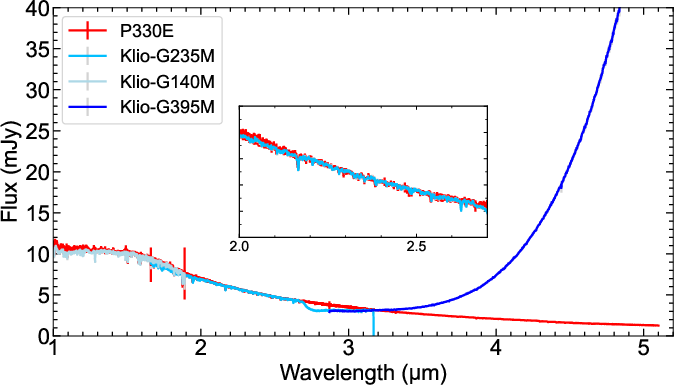
Figure 1: Irradiance spectrum of Klio obtained with NIRSpec using three grating-filter combinations; thermal emission dominates above ∼3.3 μm.
Thermal Modeling and Physical Properties
Thermal emission was isolated using the NEATM, fitting the 4–5 μm region to derive Klio's diameter (D=78.1±23.9 km) and beaming parameter (η=0.96±0.15). The geometric albedo was calculated as pV=0.05±0.03, consistent with IRAS and NEOWISE results. The NEATM fit shows a deviation below 3.5 μm due to a broad absorption band, indicating the presence of hydrated minerals.
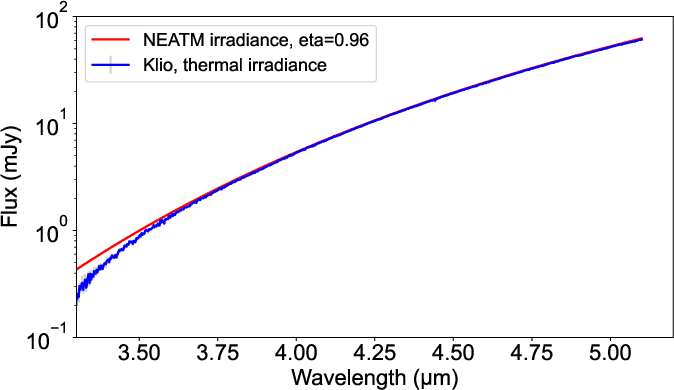
Figure 2: Thermal emission in Klio's spectrum (blue) fitted with the NEATM model (red); deviation below 3.5 μm is due to a broad absorption band.
Reflectance Spectroscopy and Mineralogical Analysis
After thermal subtraction and division by the solar analogue, the reflectance spectrum of Klio was obtained and normalized at 2.6 μm. The spectrum exhibits a prominent absorption band at 2.776 μm, attributed to phyllosilicates, and a weaker feature at 3.9 μm, potentially due to carbonates. No robust evidence for organics at 3.4 μm was found.
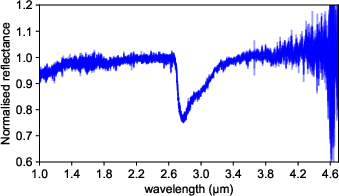
Figure 3: Klio reflectance spectrum after thermal subtraction and normalization; main features at 2.8 and 3.9 μm.
2.8 μm Band: Phyllosilicate Signature
The 2.8 μm band was analyzed via continuum division and multi-Gaussian fitting, yielding a peak at 2.776±0.001 μm and a depth of 23.9±0.1%. Comparison with laboratory spectra of CCs (measured under asteroid-like conditions) and returned samples from Ryugu and Bennu shows that Klio's band position and shape are most consistent with certain CM2 meteorites (e.g., Murchison, MAC 02606, LAP 03786, QUE 97990).
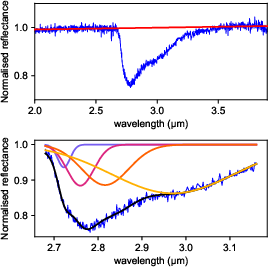
Figure 4: Gaussian decomposition of the 2.8 μm region; the sum of four Gaussians fits the continuum-divided reflectance spectrum.
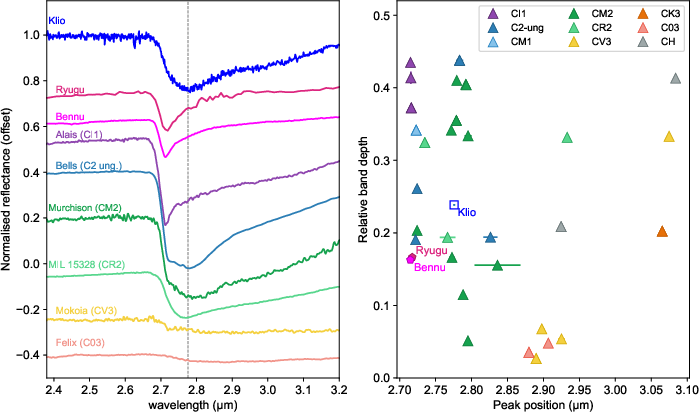
Figure 5: Spectral comparison of the 2.8 μm band between Klio and CCs, Ryugu, and Bennu samples; Klio's band position matches CM2 chondrites.
Quantitative assessment using Euclidean distance in the 2.67–3.10 μm range confirms the closest spectral analogues are CM2 chondrites, with LAP 03786, QUE 97990, and Bells (C2-ung) showing the smallest distances.
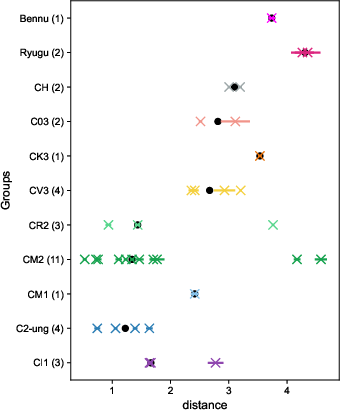
Figure 6: Euclidean distance of chondrite and sample spectra to Klio; CM2 group shows the closest match.
3.4 μm and 3.9 μm Bands: Organics and Carbonates
The 3.4 μm region was examined for organics and carbonates via polynomial continuum division and Gaussian fitting. The band is weak and its parameters are highly sensitive to continuum definition, precluding a definitive detection. In contrast, the 3.9 μm band is clearly present (3.884±0.004 μm, depth 0.020±0.001), consistent with the ν1+ν3 combination mode of carbonate minerals.
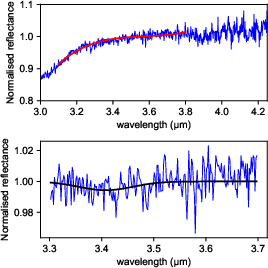
Figure 7: Gaussian fit to the continuum-divided reflectance spectrum in the 3.4 μm region; no robust organic feature detected.
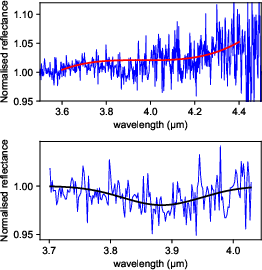
Figure 8: Gaussian fit to the continuum-divided reflectance spectrum in the 3.9 μm region; clear carbonate absorption band.
Discussion: Compositional Constraints and Implications
The spectral features of Klio, particularly the 2.8 μm band, indicate a surface dominated by Fe/Mg phyllosilicates, with compositional affinity to CM2 chondrites. The presence of the 0.7 μm band in the visible further supports this link, as it is a proxy for Fe-rich phyllosilicates and hydration. The degree of aqueous alteration inferred from the band position suggests Klio's surface is similar to CM2 subtypes 2.1–2.5, but precise quantification is limited by the lack of overlap in alteration scales among meteorite studies.
Space weathering effects, such as solar wind irradiation, are expected to shift the OH band to longer wavelengths and reduce band depth, as observed in laboratory simulations and Ryugu surface samples. Thus, Klio's surface composition may be more Fe-rich and less altered than its deeper layers.
The detection of a carbonate band at 3.9 μm is significant, as carbonates are markers of aqueous alteration and parent body processing. The absence of a clear organic band at 3.4 μm may be due to space weathering or low abundance.
Comparative analysis with Ryugu and Bennu samples shows that Klio is not a likely parent body for these NEAs, as their spectra are more consistent with CI1 chondrites, while Klio matches CM2. This reinforces dynamical models favoring low-inclination families (e.g., Polana) as sources for Ryugu and Bennu.
Conclusion
JWST/NIRSpec spectroscopy of (84) Klio provides robust constraints on its mineralogy and alteration history. The asteroid exhibits a strong 2.8 μm phyllosilicate band, matching specific CM2 chondrites, and a clear carbonate feature at 3.9 μm. The absence of a detectable organic band at 3.4 μm may reflect space weathering or compositional differences. These results refine the compositional taxonomy of inner belt C-complex asteroids and inform models of volatile distribution and parent body evolution. Future work should focus on high-resolution mapping of family members and laboratory calibration of alteration scales to further constrain the aqueous history and space weathering effects on primitive asteroids.







